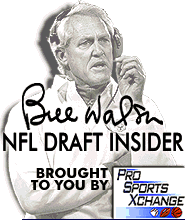
How I Evaluate Each Position:
Cornerback
By Bill Walsh
PSX Draft Insider Special
|
|
How I Evaluate Each Position: Cornerback By Bill Walsh PSX Draft Insider Special |
CORNERBACK
Ideal size: 6-2, 195, but good ones come in all sizes
You would prefer a good-sized cornerback, but fortunately they have come in all sizes. Some of the best coverage men have been extremely small and dwarfed by their wide receivers and still were able to cover because of quickness, explosion and anticipation.
But the great cornerbacks have been able to play a physical game with receivers. They can bump the receiver on the release, but more important go up for a ball and not be overwhelmed or knocked off the pass by the receiver.
Of course, you need quickness and explosion. Full-sprint speed is important, but there have been cornerbacks who have overcome a lack of sprinters' speed and played many years and become Pro Bowl participants. You'd like to think of the cornerback being able to run 40 yards in under 4.5 seconds.
He must be able to do the kinds of things receivers do when they go up for a ball.
The great cornerbacks have been good against the run, too. These are support people who can take the ball-carrier one-on-one after all the blockers have committed themselves. And among the greatest cornerbacks, there were those who could go underneath a pulling guard and cut him down and obstruct the ball-carrier who is right behind him.
Mel Blount of the Steelers in the 1970s was a great all around corner, then Ronnie Lott when he played corner in the early 1980s, and the Raiders may have had one of the best two cornerbacks with all around ability in Mike Haynes and Lester Hayes, who were dominant in Super Bowl XVIII.
Ideally , you would like to have the complete corner. But you can find a way to use that cornerback who must tighten up on his receiver and be as physical as he possibly can to take away the receiver's quickness. Donnell Woolford of the Bears is excellent in bump and run, but not quite as outstanding in reacting.
Then there are cornerbacks who have the type of quickness, explosion and anticipation that you want them to be able to see the ball thrown and move to it. So even in man to man coverage, they read the quarterback and the receiver and get a jump on the ball.
Along with all these physical abilities, the cornerback must be emotionally resilient. He must continue to function after passes have been thrown in his vicinity, or after he has given up a touchdown pass. It takes a totally composed athlete to put aside these types of plays that will be obvious for everybody to see and judge. So they must have an inner confidence, to the point of cockiness, that demonstrates itself.
Your rarely get the complete package. Willie Brown, Blount, Haynes, Lott -- those were among the very few who were accomplished at the diverse talents necessary to play this very difficult position. Lott, of course, is the only player ever to make the Pro Bowl at all three defensive back positions, corner, free safety and strong safety.